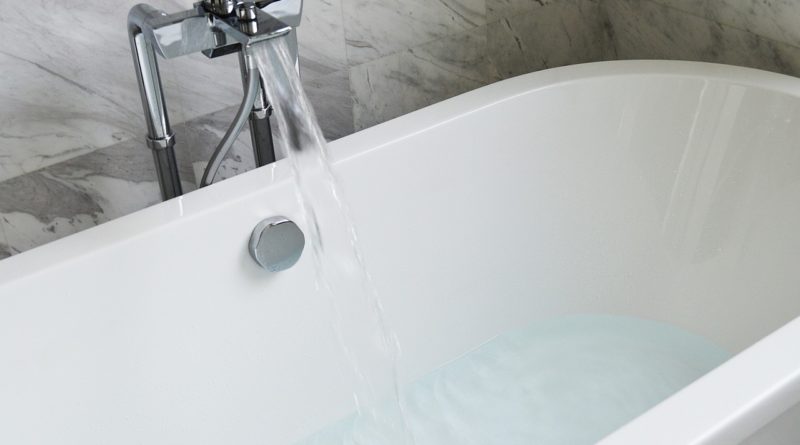How to Unclog Your Bathtub Drains Yourself
Over time, bathtub drain clogs happen to almost everyone. That’s because the two main causes of these clogs —soap residue and clumps of head and body hair — build up gradually in the vast majority of tub drains as a natural consequence of bathing and showering. Unlike some plumbing problems, clogged bathtub drains typically respond well to do-it-yourself remedies. Let’s take a look at the steps you can take to successfully unclog the tub drains in your home.
Removing the Drain Stopper
Typically, the first step in unclogging a bathtub drain is the removal of the stopper that drops into place when you fill your tub for baths. Most bathtubs have a type of stopper known as a drop stopper, which features a raised knob in its center. All you need to do to remove a drop stopper is lift it up, loosen a set screw that connects the top of the stopper to its shaft, and slide the top free.
If you have an older bathtub, it might be equipped with something called a levered stopper, which gets its name from the little lever that lowers the stopper into place. In this type of setup, the stopper does not actually cover the drain. Instead, the lever lowers and raises the stopper inside a vertical overflow tube that runs in back of the front wall of the tub. The visible drain in your tub connects to this tube through a short section of pipe. You may not need to remove the stopper in order to unclog the drain on this type of tub. If you do need to take this step, just unscrew the plate that holds the lever and pull out the stopper, which is attached to a chain-like device called a linkage.
Some bathtubs have push/lock drain stoppers. As their name indicates, these stoppers block your tub drain when you push them down with your hand. A second push will bring the stopper back up. To remove a push/lock stopper, you must pull it up, hold onto its stem, and unscrew the top-mounted cap. Once you perform this step, you may be able to clear the clog. However, you may also need to go further and unscrew the whole stem.
Clearing Visible Clogs
Once you remove the stopper from a tub equipped with a drop stopper or a push/lock stopper, you may be able to see soap residue or clumps of hair. Similarly, you may see residue or hair on the screen that covers the drain in a tub with a levered stopper. If so, in a best-case scenario you just need to remove this material in order to end your clogging problems. In the case of a hair clump, you can avoid using your hands by fishing out the clump with the tip of a bent wire coat hanger.
Using a Plunger
If you can’t see the source of the clog in your drain, you have several options to remedy the situation. First, you can try using a standard-issue household plunger. Begin by filling your tub high enough to submerge the lower portion of the plunger in water. If your bathtub has a levered stopper, also make sure to remove the lever plate, linkage and stopper, and plug the opening to the overflow tube with a rag. Next, position the plunger over the drain, lower it until it touches to tub and push down vigorously a few times. Hopefully, the pressure produced by your actions will dislodge the clogged material and push it out through your plumbing line. If you don’t succeed on the first go, give it at least one more try before moving on the next potential solution.
Using a Drain Stick
If a plunger won’t clear your bathtub drain clog, the next step is typically a device called a drain stick. This relatively short, narrow and flexible device — most often made from some form of plastic — has a series of barbs on each side similar to the thorns on a rose bush. When you gradually insert the stick into your drain, it should reach at least down to the point where the drain trap creates a bend in the pipe. In some cases, the forward motion of the stick may dislodge the clogged material. If not, then the barbs on the sides of the stick should latch onto the material (especially hair) and allow you to clear the clog when you pull the stick back out. Be sure to insert the drain stick down the overflow tube if your tub has a levered stopper.
Using a Drain Snake
If a drain stick doesn’t work, you may have a clog further down your drain line. In this scenario, you probably want to move up to a device called a drain snake. This device is essentially a longer, flexible metal cable coiled up inside some sort of hand-held housing. You can use the handle on the housing to feed the cable gradually down your drain, past the drain trap and further down the pipe. In some cases, you may actually feel the clog when the snake reaches it. Like a drain stick, the snake will sometimes dislodge the clog and push it forward; however, it can also work by pulling the clogged material back out of the drain when you retract the snake. You may need to snake your drain one or two more times before you can tell for sure if this approach will work.
What About Chemical Drain Cleaners?
You can use chemical drain cleaners to unclog a bathroom drain. However, you should keep a couple of considerations in mind. First, chemicals powerful enough to eat away a drain clog are also powerful enough to cause significant environmental damage. You may not want to introduce such potentially harmful substances into your local watershed. In addition, keep in mind the dangers associated with plunging a drain after you use a chemical cleaner. Even small droplets of the cleaner can damage your skin, or damage your vision if they come in contact with your eyes.
You Can Always Call Your Plumber
At the end of the day, you might feel like you’re not getting anywhere with your DIY efforts to unclog your bathtub drain. You may also simply lack the time to try multiple do-it-yourself solutions. In either situation, you can always ask your local plumbing professional to handle the job. A trained and experienced plumber will be able to properly diagnose and resolve any issues affecting your tub.

